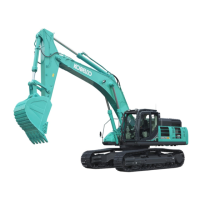
Do you have a question about the Kobelco SK500XDLC-10 and is the answer not in the manual?
| Brand | Kobelco |
|---|---|
| Model | SK500XDLC-10 |
| Category | Excavators |
| Language | English |
Read, understand and follow the safety messages and instructions in this manual.
Always store all manuals for this machine and any attachments in the pocket located at the rear side of the operator's seat.
Accidents result from not following basic safety precautions; recognize hazardous situations.
Safety labels alert operator and personnel of hazardous situations during operation, inspection or maintenance.
Details the applicable works and provides front, rear, right, left orientation of the machine.
Operators must meet country-specific licensing or qualification requirements for hydraulic excavators.
Ensuring the function of ROPS and falling objects protective structures by proper use and maintenance.
Information needed for ordering parts and service: machine serial number, engine serial number, and current hours.
Details KOBELCO's responsibility for repairs or replacements as per the attached warranty.
Illustrations may show parts removed; safety parts must be installed before operation.
Ensuring safety labels are legible and not damaged; cleaning, replacing, and never removing them.
Details various safety labels including 'DO NOT USE COUNTERWEIGHT LIFTING EYES' and 'WORKING ABOVE GROUND'.
Ensuring worksite safety, knowing your machine, and keeping others away during operation.
Personal protective equipment (PPE) required for tasks and preparing for emergencies.
Procedures for handling machine failures, and emergency escape from the cab.
Attention to falling materials, flying debris, and limited protection from objects falling on the cab.
Preventing fires caused by flammable substances, electric systems, leaks, and using anti-explosion work lights.
Precautions for safe mounting and dismounting of the machine, emphasizing three points of contact.
Performing pre-startup checks, attaching 'DO NOT OPERATE' tags, and inspecting seat belts.
Being aware of surroundings, adjusting mirrors, and cleaning rearview camera for improved visibility.
General precautions before starting, including checking 'DO NOT OPERATE' tags and working sites.
Checks before starting the engine, including warning tags, operator in cab, and site barricades.
Confirming direction of travel, moving travel levers slowly, and precautions during traveling.
Never use swing power, travel power, or bucket for hammering/piling operations.
Caution in constrained areas like tunnels or near power lines; use signal person.
Never move suspended load or bucket over a person or truck cab to prevent serious injury or death.
Maintain safe distance from power lines, never violate minimum clearance, and use a signal person.
Procedures for safely parking the machine on firm ground or on a slope.
Procedures to secure the machine at the end of the shift, including cleaning and refueling.
General precautions before performing inspection and maintenance activities.
Carefully read procedures, confirm job procedures, use signal person, organize site, and attach 'DO NOT OPERATE' tags.
Stop engine, cool down hot fluids, and be aware of high pressure oil hazards.
No welding on structural parts without manufacturer/dealer approval; do not heat piping with flammable oil.
Confirm no leaks, controls function properly, and proper waste disposal of fluids.
Prevention of electrolyte burns and battery explosions; wear PPE and keep away ignition sources.
High pressure nitrogen gas is sealed; never disassemble, drill, or weld accumulators/gas springs.
Procedures to prevent injury during towing, including proper wire rope use and machine positioning.
Diagrams and list of basic components of the machine, identifying major parts.
Diagrams and list of parts within the operator's station, including controls and displays.
Description of the gauge cluster components: meter, switch panel, and multi-display.
Overview of the multi-display functions: Main Screen, Warning Display, User Menu, etc.
Instructions on how to cycle through display screens like fuel efficiency graph and logo mark.
Function of the buzzer stop switch and warning classification chart with priority levels.
Selection of proper work mode (S, E, H) according to work condition and purpose.
Operation of the washer switch to spray washer fluid through the front window nozzle.
Selecting travel speed (LOW 1st/HIGH 2nd) for different ground conditions and applications.
Activating the auto acceleration system to set engine speed to low under specific conditions.
Switching between Digging, Nibbler, and Breaker modes to match the installed attachment.
Using the menu switch to display the user menu and access settings.
Available settings in the user menu, including maintenance schedule, auto warming up, and clock.
Displaying remaining time for recommended replacement intervals of engine oil, fuel filter, hydraulic oil filter, and hydraulic oil.
Understanding warning display priority and actions required for classification charts.
Information on the hydraulic oil filter clogging detector and how to release the warning.
Procedures for operating various switches and understanding meter functions.
Operation of the starter switch for starting, stopping, and accessory mode.
Adjusting engine speed output using the dial type rotary switch.
Turning on and off the working lights on the boom and deck.
Using the heavy lift switch for lifting heavy loads and requiring extra power.
Using the pressure release switch to release the inner pressure of the hydraulic circuit.
Using the switch to install and remove front attachments from the quick hitch.
A location to install an optional switch.
Using the horn switch to warn surrounding personnel before starting the machine.
Using the power boost switch for increased digging force during specific situations.
Using the throttle for redundant mode when controller has trouble.
Using the switch only when the swing parking brake cannot be released due to trouble.
Using the switch when the controller has trouble to operate the machine.
Using the switch to stop the engine when normal methods fail.
Using the 12V power supply for accessories like fans or mobile phones.
Connecting external sound devices and USB memories for music playback.
Monitoring the level gauge to determine if the machine is kept in a horizontal position.
Understanding the function and operation of various levers and pedals.
Identifying the locations of the pilot control shut-off lever, operator control levers, and travel levers.
Preventing unexpected operation by locking the control levers and travel levers.
Operating swing, arm, boom, and bucket controls; ensuring correct control pattern.
Handling travel levers for forward, backward, and neutral positions; confirming crawler frame direction.
Understanding the fuse and relay box and procedures for replacing fuses.
Procedures for replacing blown fuses, ensuring correct type and capacity are used.
Table detailing fuse capacities and their corresponding circuit names for troubleshooting.
Proper use of the battery power-off switch and understanding the function of the fusible link.
Information about the machine and engine controller, and precautions against water and dirt.
Operating the radio, including identifying parts and understanding functions like power, source, and volume.
Lists receivable frequencies for FM/AM radio bands in different regions.
Switching between RADIO and EXTERNAL input sources using FM/AM and ENTER keys.
Procedures for receiving FM/AM broadcasts and recalling preset frequencies.
Playing MP3/WMA files from USB memory, including supported formats and play controls.
Connecting cell phones or audio players via Bluetooth for music playback.
Switching between 24-hour and 12-hour display formats for the clock.
Adjusting the volume level output from the radio, either step-by-step or continuously.
Changing display modes for FM/AM, USB, Bluetooth Audio, and AUX sources.
Accessing and changing set values within the menu for adjusting clock and pairing.
Details Bluetooth audio, USB, and AUX terminal functions, including specifications and compatibility.
Functionality of the air conditioner for temperature control and dehumidification within the cab.
Overview of the control panel switches and LCD display functions.
Instructions for cooling method and heating method using the automatic air conditioner.
Checking for problems in motor actuators, evaporator, and recirculation air sensors via monitor mode.
Proper usage and maintenance of the air conditioner during active and inactive seasons.
Installation, fastening, and unfastening procedures for the seat belt.
Adjusting seat position for operator comfort and control accessibility.
Adjusting the control stand forward and rearward for better operator ergonomics.
Adjusting the angle and position of the arm rest for operator comfort.
Adjusting the head rest position for optimal support.
Adjusting the seat suspension based on operator weight.
Procedures for handling parts located inside the cab.
Locking the cab door securely in open or closed position to prevent unexpected movement.
Procedures for opening and closing the upper front window securely.
Removing and storing the lower front window.
Operating the switch to turn the cab room lamp on or off.
Procedures for emergency escape from the cab via front or rear window.
Information on various accessories like tool box, holders, and cup holder.
Using the tool box for storing tools and fixtures; securing it with the starter key.
Procedures for unlocking, opening, locking, and closing guard/side doors.
Operating the battery power-off switch to shut down electrical circuits for maintenance or long storage.
Performing walk-around checks before starting engine for loose parts, leaks, and overall machine condition.
Performing daily checks on coolant, engine oil, fuel levels, and pre-filters.
Procedures for checking and refilling coolant in the reserve tank and radiator.
Checking engine oil level using the dipstick and refilling if necessary.
Checking fuel level and refueling procedures, emphasizing diesel fuel and safety precautions.
Draining accumulated water from the fuel pre-filter to ensure proper fuel supply.
Checking hydraulic oil level using the sight gauge and refilling if low.
Checking belts for wear, damage, and tension, and adjusting them properly.
Adjusting seat height, tilt, reclining, and position for operator comfort and control access.
Adjusting cab mirrors for maximum visibility and minimizing blind spots.
Verifying the display status of the multi-display on the gauge cluster before starting the engine.
Testing the working lights on the boom and front.
Procedures for starting the engine, including safety checks and warm-up.
Steps for starting the engine in standard temperature conditions, ensuring controls are neutral and throttle is low.
Procedures for starting the engine in cold weather, considering oil viscosity and battery performance.
Safe procedures for starting the engine using jumper cables, emphasizing correct connection and voltage.
Steps to properly stop the machine engine, including lowering attachment and removing key.
Inspecting machine functions after starting the engine, including pilot control shut-off lever and engine multi-display.
Importance of warming up the engine and hydraulic oil to prevent severe damage and ensure proper operation.
Performing warming-up of hydraulic oil after engine warming-up by circulating oil through cylinders and circuits.
Saving fuel and reducing exhaust gas by automatically stopping the engine after a specified time.
Selecting the proper work mode (S, E, H) according to work condition and purpose.
Switching attachment mode (Bucket, Nibbler, Breaker) to match the installed attachment.
Basic machine operation procedures, including precautions and understanding machine orientation.
Confirming travel motor position, using travel levers correctly, and setting travel speed.
Taking care not to immerse swing bearing in water/soil; operating on soft ground requires caution.
Procedures for getting the machine out of soft ground when one or both sides are stuck.
Operating boom, arm, bucket, and swing controls; following safety precautions.
Explains standard work procedures like digging and loading.
Techniques for efficient digging, including boom/arm angles and bucket positioning.
Efficient loading procedures for dump trucks, considering swing angle and truck position.
Procedures for safely parking the machine on firm ground or on a slope.
Checking multi-display for warnings, inspecting for leaks, refueling, and cleaning.
Precautions for operating the machine in adverse weather or ground conditions.
Precautions for operating in cold conditions, including fuel/oil, coolant, battery, and after-operation checks.
Washing the machine and applying anti-rust treatments after operating at the seashore.
Cleaning air cleaner, radiator, and starter/alternator earlier due to dust.
Steps for storing the machine for extended periods, including washing, refilling, battery, and coolant.
Monthly lubrication operation by starting and moving the machine to supply lubricant.
Treatments required before using the machine after long-term suspension, including checking hoses and refilling oil.
Importance of regular inspection and maintenance for machine function and service life.
Precautions before inspection/maintenance, stopping the engine, using warning tags, and genuine parts.
Schedules for inspection and maintenance based on calendar time or operation time.
Procedures before inspection/maintenance, stopping engine, using warning tags, genuine parts, and keeping out dust.
Details of lubricants, fuel, and coolant types and capacities for various machine components.
Precautions and procedures for using bio-oil, including flushing and replacement intervals.
List of maintenance parts, their part numbers, and replacement intervals.
Table specifying tightening torques for various bolts and nuts at specific positions on the machine.
Torque specifications for metric coarse and fine threads, with and without lubrication.
Torque specifications for ORS fittings, byte type tube fittings, and O-ring fittings.
Recommended intervals for greasing, element replacement, and inspection for engine and related systems.
Procedures for maintenance tasks that are required as needed.
Procedures for cleaning radiator, oil cooler, and screen using compressed air or water.
Checking wiper blades for wear or damage and replacing if necessary.
Checking washer fluid level and refilling if low.
Procedures for removing and installing the bucket, including pin and O-ring replacement.
Procedures for replacing worn tooth points and side cutters, including safety blocks and hammering.
Measuring and adjusting bucket gaps by loosening bolts and removing shims.
Procedures to bleed air from the fuel system after filter replacement or running out of fuel.
Releasing internal pressure in hydraulic system before replacing attachments or pipes.
Greasing grease nipples on the boom side bosses and cylinder rods.
Daily inspection and maintenance tasks, including greasing attachments.
Greasing attachment points according to specified intervals and work conditions.
Inspection and maintenance tasks for 50 hours of operation, including battery checks.
Checking battery electrolyte level, cleaning terminals, and handling batteries safely.
Procedures for draining water and sediment from the fuel tank using the drain cock.
Checking and adjusting crawler tension by applying grease to the idler adjuster.
Inspection and maintenance tasks for 120 hours of operation, including checking gear oil levels.
Checking gear oil level in travel reduction units and refilling if low.
Checking rubber hoses for damage, deterioration, and loose bands.
Inspection and maintenance tasks for 250 hours or 3 months, including belt adjustment.
Checking radiator hoses for cracks, leaks, or permanent set and replacing if necessary.
Cleaning or replacing recirculation and fresh air filters based on usage and time intervals.
Procedures for inspecting, cleaning, or replacing the outer and inner air cleaner elements.
Cleaning or replacing the radiator cap, checking its contact surfaces for foreign materials or damage.
Inspection and maintenance for 500 hours or 6 months, including replacing engine oil and filter.
Procedures for replacing engine oil and oil filter, including draining and refilling.
Procedures for replacing the fuel pre-filter element and gasket, including draining oil and bleeding air.
Procedures for replacing the fuel filter cartridge, ensuring proper tightening and bleeding air.
Greasing the swing bearing by cleaning the nipple and applying grease while swinging the upper structure.
Checking swing bearing mounting bolts for looseness and retightening with recommended thread locking agent.
Cleaning the fuel tank cap and strainer, replacing the seal if damaged.
Lubricating the push rod and rotational sliding section of the control lever.
Checking refrigerant amount and preventing leaks; operating AC weekly for compressor seal.
Inspection and maintenance for 1000 hours or 12 months, including replacing return filter.
Procedures for replacing the return filter element, noting warning displays for clogged filters.
Replacing the filter element at regular intervals to keep hydraulic oil clean.
Checking engine mounting bracket and rubber mounts for damage, deterioration, and looseness.
Measuring battery voltage and charging or replacing if below specified voltage.
Replacing the pilot line filter element after 250 hours for the first time, then every 1000 hours.
Replacing the drain filter cartridge after 250 hours for the first time.
Inspection and maintenance for 2000 hours, including replacing coolant.
Procedures for replacing coolant, including safety precautions and using genuine antifreeze.
Replacing oil in the swing reduction unit after 500 hours of operation.
Replacing oil in the travel reduction units after 500 hours of operation.
Cleaning the suction strainer in the hydraulic oil tank and checking for damage.
Applying grease to the grease nipple on the swing reduction unit.
Checking grease quality in the swing grease bath and replacing if deteriorated or contaminated.
Observing transportation regulations and contacting dealer for transport arrangements.
Contacting KOBELCO branch for transport, considering dimensions, weight, and route regulations.
Procedures for loading/unloading on level ground, using ramps, and setting engine speed and travel speed.
Steps for loading the machine onto a trailer using a ramp or platform, ensuring proper alignment and securing.
Procedures to secure the machine on the trailer using chocks and wire ropes.
Steps for unloading the machine from a trailer using ramps, ensuring proper alignment and slow movement.
Procedures and precautions for lifting the machine using wire ropes or lifting tools.
Detailed steps for lifting the machine, including extending cylinders, aligning, and securing.
Dimensions and weights of the machine with different boom, arm, and bucket configurations for transport.
Waterproofing the connector of the disconnected camera cable when the counterweight is removed or installed.
Instructions for installing and removing mirrors, referring to Chapter 3 for adjustment.
Table detailing operating mass, dimensions, engine, and performance specifications for SK500XDLC-10 and SK520XDLC-10.
Description of different grouser shoe types and their recommended uses for soft or ordinary soil.
Diagrams and tables showing digging reach, depth, dumping height, and other working ranges.
Diagram and table showing digging reach, depth, dumping height, and other working ranges for different attachments.
Details front attachment variations and recommended bucket/arm combinations for different boom specifications.
Overview of the system that manages operating information and failures of the hydraulic excavator.
Procedures for automatic software renewal (download) of the controller, including update acceptance and process.
Selection, installation, and precautions for using hydraulic nibblers and breakers.
Do not pry or break forcibly; do not use breaker for other than intended purpose; avoid hitting.
Do not use breaker for moving debris; avoid excessive loads on boom/arm/breaker.
Never use the breaker for lifting work, as it can cause accidents.
Avoid operating breaker in water to prevent rust and damage to sealed portions and hydraulic components.
Limit lifting amount during breaker work to 10-15cm to avoid boom/arm damage.
Protect operator from debris; do not pry objects or use for unintended purposes.
Avoid traveling while holding object with nibbler; this can cause crawler damage and instability.
Switching attachment mode (Bucket, Nibbler, Breaker) according to installed attachment.
Matching attachment mode to installed equipment for proper function and to avoid malfunction.
Selector valve switches hydraulic oil flow automatically based on attachment mode.
Using stop valves to stop hydraulic oil flow when installing/removing attachments.
Adjusting service circuit flow rate based on the installed attachment for proper operation.
General operation methods for attachments like nibblers and breakers, emphasizing safety.
Using the device to lock the pedal, preventing accidental attachment movement.
Understanding pedal operations for hydraulic breaker and nibbler, showing oil flow direction.
Operating extra controls, nibbler, and breaker using switches on the control levers.
Using the slide switch on the left control lever to actuate extra functions.
Operating the nibbler (crusher) using the slide switch on the right control lever.
Operating the breaker using the press switch, showing oil flow and release procedures.
Maintenance chart for hydraulic oil and filter replacement intervals for nibbler/breaker use.
Reading precautions for using the breaker and installing an accumulator if required.
Switching the multi-control valve and checking control lever patterns.
Handling of quick hitch, including precautions and prohibited works like lifting.
Checking operation manual, operating range, lifting capacities, and quick hitch operation switch.
Procedures for safely removing the front attachment using the quick hitch.
Procedures for safely installing the front attachment using the quick hitch, ensuring secure attachment.
Description of the dual monitor installed for monitoring the machine's right side during operation.
Accessing setting items like PICTURE, CAMERA, and DIMMER from the main menu.
Adjusting picture settings like brightness, color, contrast, and tint.
Adjusting camera related items, including 90-degree rotation of the right side picture.
Adjusting the dimmer level for ON (light reduction) and OFF states of the screen.
Information on the right side camera, including viewing angles and blind spot range.

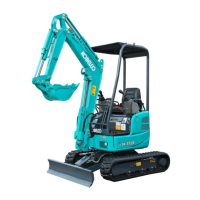
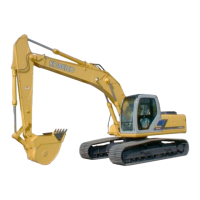

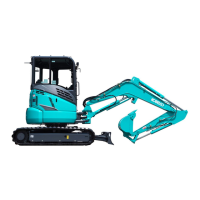



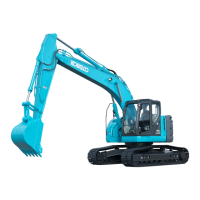



